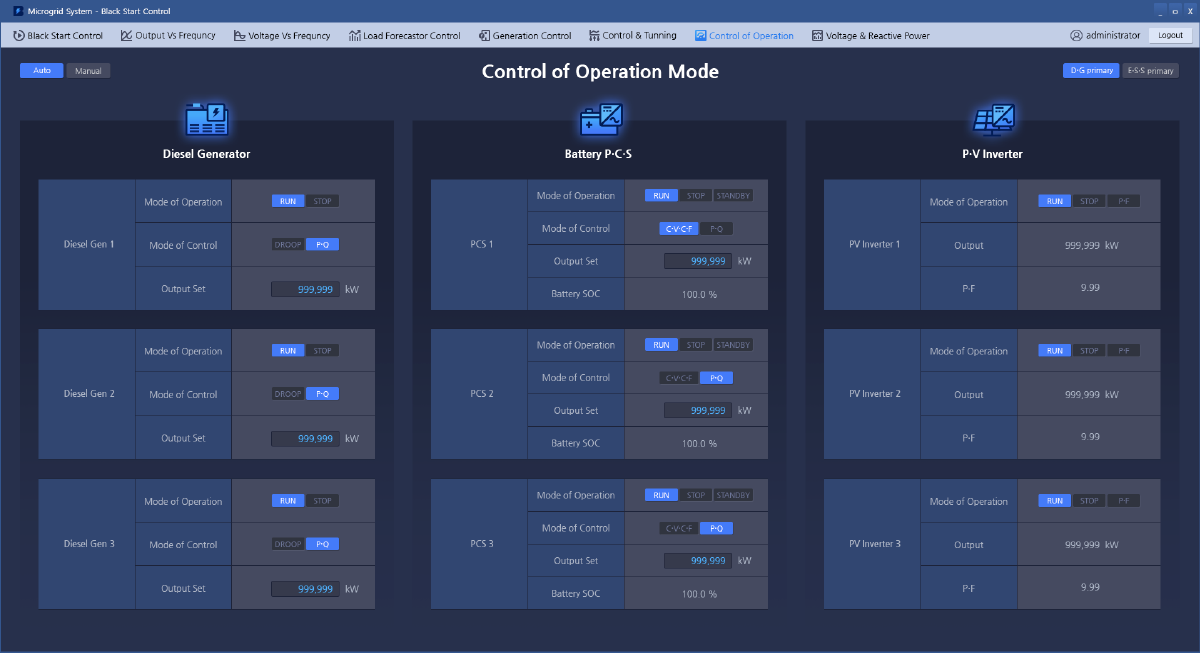Microgrid Energy System
Today’s facilities and communities are under extreme pressure to improve performance, operational efficiencies and reduce costs. Continuous availability of electricity is critical to meet these goals.
A microgrid is a stand-alone power grid that can be self-sufficient stand alone power system in a small area.
It is a power system that combines various energy production devices such as diesel generators, solar and wind power and energy storage devices. Unlike large-scale power generation facilities, it does not require a separate power transmission facility due to its proximity to supply area.
Download brochure

Values from microgrid energy system

|
Separate electricity transmission line free
|
|---|

|
Renewable farming
|
|---|

|
Islanding
|
|---|

|
Frequency & voltage regulation
|
|---|
Benefits are significant

Microgrid System
| 1 |
Modularized and containerized system |
|---|---|
| 2 |
Shorter project cycles |
| 3 |
Improved overall cost effectiveness |
| 4 |
Easier to troubleshoot |
| 5 |
Easy reconfiguration of equipments |
| 6 |
Turnkey and full lifecycle support |
| 7 |
Single point of responsibility |
Consistent power supply
Consistent supply of reliable, efficient and high-quality power
Adaptable infrastructure
An adaptable, secure and responsive infrastructure
Enhanced safety
Enhanced safety to protect people, property and the environment
Expandable architecture
An architecture that can grow and modified without major reengineering
Integrated solution
" Total solution provider for microgrid energy system "
We are devoting ourselves to improving people’s lives and environment with power management technologies that are more reliable, efficient, safe and sustainable. Because that is what really matters. And we are here to make sure it works.
Unbro have been incorporating our all existing and on going technologies of development into our microgrid energy system.

Microgrid EMS system

- Utilizes modular systems design
- Standard set of displays/reports
- Repeatable gen modules (templates)
- Scale templates to match application
- Pre-format load options
- Build on open standards
- Suit of pre-engineered optimization strategies
EMS software for microgrid system
Automated microgrid system startup
This function greatly simplifies the execution of complex black start process. It verifies the status of each step and automatically performs all processes moving to the next step. With just one button operation, the user can perform all processes at once.

Automatic scheduling and system operation
This function uses intelligent load & generation forecasting algorithm. This function creates operation schedule automatically. With this automated scheduling function operator can run entire plant without burden of creating complex schedule.

Modularized control block
Our control system adopted modularized algorithm block architecture. Each algorithm block is built with the function of most frequently used. In most cases we do not need extra customization work. We just need to combine each block for operation.

Type of microgrid EMS software & function
| Function | Basic version | Standard version | Enhanced version |
|---|---|---|---|
| Grid forming & control (Microgrid function) | - |  |
 |
| Black start (Automatic start and shutdown of microgrid system) | - | - |  |
| Demand forecasting (Demand forecasting function based on history data) | - | - |  |
| P.Q control (Active & Reactive power control) |  |
 |
 |
| Frequency & Voltage control | - |  |
 |
| P.F control (Power factor control) | - |  |
 |
Microgrid GUI design

Microgrid EMS software GUI
- Black Start Control
- Control of Operation Mode
- Load Forecastor Control
- Economic Generation Control
- Output Vs Frequncy
- Voltage and Reactive Power Output
• Black Start Control
 The automated blackstart function of microgrid enables operators to recover microgrid system with minimum human intervention.
The automated blackstart function of microgrid enables operators to recover microgrid system with minimum human intervention.
With few key strokes to microgrid control system, it automatically monitors each individual equipment’s status and make entire generation system to be ready to execute automated blackstart function.
The automated black start function involves starting up the microgrid's generation sources such as diesel generators, renewable energy and energy storage systems. Microgrid control system monitors each generation source’s status and system capacity. If microgrid control system decides to start to execute automated blackstart function, it controls and monitors every step of blackstart procedure until microgrid system recovers to perform it’s normal microgid function based on pre-programmed scenario and sequence. It does not need manual or human intervention. Overall, an automated black start function is a crucial component of microgrid resiliency, ensuring that the microgrid can quickly recover from a power outage and continue to provide power to critical loads.
• Control of Operation Mode
 The control of the mode of operation of equipment in a microgrid, such as a generator, PV inverter, and battery PCS, involves managing the mode of output of each device to meet the electricity demand (frequency and voltage). The mode of operation consist of different operating modes to ensure to achieve this target.
The control of the mode of operation of equipment in a microgrid, such as a generator, PV inverter, and battery PCS, involves managing the mode of output of each device to meet the electricity demand (frequency and voltage). The mode of operation consist of different operating modes to ensure to achieve this target.
Generator Control : In a microgrid, the generator may be used as the primary source of electricity or as a backup power source. Generators can be based on Droop control or P.Q control.
PV Inverter Control : A PV inverter may operate in modes such as maximum power point tracking (MPPT) mode, where it adjusts the output voltage and current to extract the maximum power from the solar panels. Or the inverter may also operate in P.F control mode to regulate the voltage of the microgrid and maintain system stability.
Battery PCS Control : The battery PCS manages the charge and discharge of battery. Also one of P.C.Ss of battery system will operate on C.V.C.F (Constant voltage and constant frequency) mode while the others operate in P.Q mode.
Mode of operation of each equipment will be defined automatically or manually by microgrid control software.
• Load Forecastor Control
 Load forecasting is done using the “similar day forecasting” prediction technique. The “similar day forecasting technique” is based on the theory that power consumption (load) shows a certain pattern under the influence of days of the week, seasons, time zones, and weather condition such as temperature, wind strength, and humidity. For forecasting, historic load data with weather informa- tion of past years are required, but if they are not available, the forecast is performed based on the data of the previous week or the previous day.
Load forecasting is done using the “similar day forecasting” prediction technique. The “similar day forecasting technique” is based on the theory that power consumption (load) shows a certain pattern under the influence of days of the week, seasons, time zones, and weather condition such as temperature, wind strength, and humidity. For forecasting, historic load data with weather informa- tion of past years are required, but if they are not available, the forecast is performed based on the data of the previous week or the previous day.
If there is usage data linked with past weather data, first input the weather factors such as temperature and humidity on the day to be predicted, and the system sets the characteristic conditions of the forecast day (Ex: Sunday, Saturday, Ordinary day, Christmas, Thanksgiving, First day of new year), etc. Based on this, 30 data with the most similar temperature and humidity are extracted by date type, season, and temperature and humidity, and the load is predicted by assigning weights for each temperature and humidity. Considering the natural increase in usage, software estimates the total demand.
• Economic Generation Control
 Microgrid system typically includes multiple distributed energy resources such as solar photovoltaic (PV) panels, battery system, and generators. The economic generation and dispatch of electricity in a microgrid involves optimizing the use of diesel generators.
Microgrid system typically includes multiple distributed energy resources such as solar photovoltaic (PV) panels, battery system, and generators. The economic generation and dispatch of electricity in a microgrid involves optimizing the use of diesel generators.
The economic dispatch of electricity of microgrid is focused on “How we can minimize running fuel engine based generators” and “How we can maximize the use of renewable energy”.
In order to achieve that objective, the future demand forecasting, optimal energy storage level, Optimal necessary running of fuel engine based system running should be considered and reflected in automated operation.
• Output Vs Frequncy
 Frequency control function is needed to provide adequate amount of electricity and maintain reference frequency to microgrid system. The frequency of the electrical power system is measure of how enough or deficient the supplying amount of electricity to demand side. So frequency needs to be maintained at a constant level to ensure that the power supply is stable and reliable.
Frequency control function is needed to provide adequate amount of electricity and maintain reference frequency to microgrid system. The frequency of the electrical power system is measure of how enough or deficient the supplying amount of electricity to demand side. So frequency needs to be maintained at a constant level to ensure that the power supply is stable and reliable.
In a microgrid, the frequency control function of microgrid system continuously monitors the frequency of the electrical power system, amount of Active power and size of demand variation to adjusts the output of the generation sources to maintain a stable frequency. If the frequency deviates from the set point, the frequency control system triggers the necessary adjustments in generation sources to restore the frequency to the desired level.
• Voltage and Reactive Power Output
 Voltage control function in microgrids is basically adding or subtracting reactive power to microgrid system.
Voltage control function in microgrids is basically adding or subtracting reactive power to microgrid system.
If there is too much reactive power flow, then voltage may increase. Especially in microgrid system, if there is surplus power flow is made from renewable energy sources to microgird, this voltage rise phenomenon may occur.
In a microgrid, the voltage control system continuously monitors the voltage of the electrical power system and controls the output of the reactive power genera- tion to maintain target voltage.
